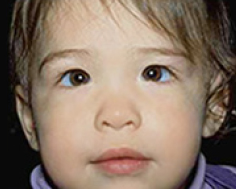What is Pseudoesotropia?
Pseudoesotropia refers to the appearance of crossed eyes in a child whose eyes are actually perfectly aligned.
Pseudoesotropia is one of the most common causes of infant referral to an ophthalmologist.
What Causes Pseudoesotropia?
Pseudoesotropia occurs in children who have a broad, flat bridge of the nose and/or pronounced epicanthal folds which allow the skin on the inner part of the eyelids to extend over and cover the inner part of the eye.
It is most common in infants and younger children whose facial structures have not yet fully developed. Also young children of Asian descent more commonly demonstrate this due to the anatomy of the Asian eyelid.
As a result of this broad nasal bridge the sclera (the white part of the eye) closest to the nose becomes less visible and gives an illusion of crossed eyes. This becomes more obvious when the child looks toward either side and may be especially noticeable in photographs.
Making the Diagnosis…
Your doctor will carefully perform all of the necessary tests to rule out true eye crossing and confirm that your child has pseudoesotropia. This includes an examination with dilating eye drops to determine the degree of farsightedness and to make sure the eyes are otherwise
Treatment
No treatment is required for pseudoesotropia.
Parents can be assured that their child will most likely outgrow this optical illusion of eye crossing over time. As the face matures and the nasal bridge grows, the skin is pulled inward and away from the eye, thereby making more of the sclera (the white part of the eye) closest to the nose visible and thus diminishing or eliminating the crossed eyed appearance.
Why is Good Ocular Alignment Important in Children?
When a true significant ocular misalignment exists in childhood, the developing visual system does not acquire “binocular vision”. This refers to the brain’s ability to use both eyes together as a single unit. Aside from enjoying improved depth perception and fine motor skills, a person with binocular vision tends to maintain good ocular alignment throughout life.
Additionally, a child with good ocular alignment is at decreased risk for developing amblyopia (poor vision in one or both eyes due to the brain ignoring the visual input).
Future Considerations…
Parents and pediatricians should be cautioned that reassessment in the future may be required in the event that the appearance of eye crossing worsens or does not improve over time.

Pseudoesotropia as a result of a broad bridge of the nose. This is not a real eye crossing.
Pediatric Ophthalmic Consultants
40 West 72nd Street, New York, NY 10023 | 212-981-9800
The content of this Web site is for informational purposes only. If you suspect that you or your child has any ocular problem,
please consult your pediatrician, family practitioner, or ophthalmologist to decide if a referral to a pediatric ophthalmologist is required.




